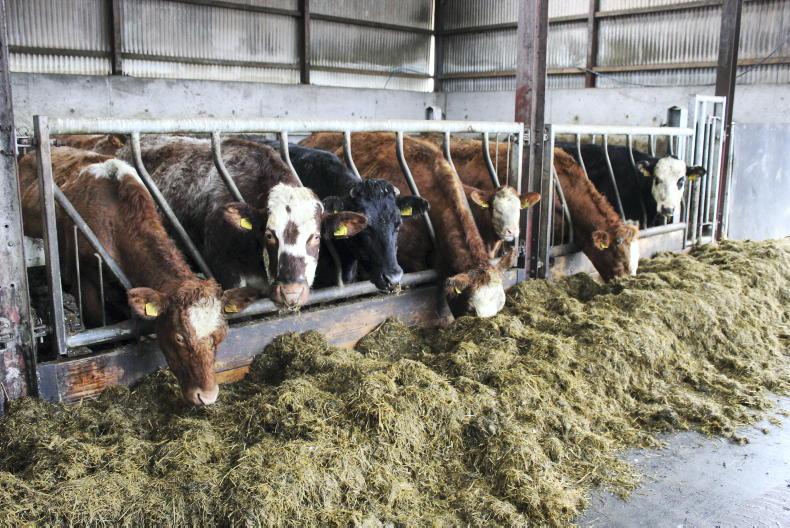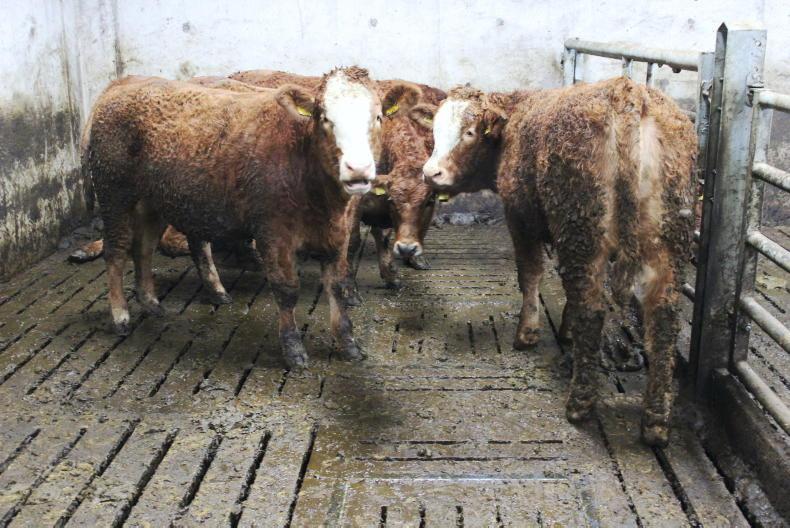Breeding finished up for our autumn-calving suckler herd back in early December and the cows have now been pregnancy-scanned.
Scanning results were positive, with 22 cows settled in-calf, along with 10 home-bred heifers. All cows and heifers are calving within a six-week window starting in early August, according to scan results.
The cows are all settled in-calf by a Stabiliser stock bull, while the heifers are served to Angus bulls through AI.
There were six autumn-calving cows that did not go to the bull for various reasons. With such a strong beef trade of late, these cows were weaned early and cashed in.
Their calves are August-born animals and were eating 2kg/day of concentrate when weaned.
They experienced no setback since they came off the cow and appear to be doing well since then. Once weaned in early January, the cows were killed, as they were in great condition.
Winter feeding
With the autumn cows now settled in-calf, they have been moved on to a silage-only diet. First-cut silage is excellent, with a feed of 73.8% D-value and more than capable of maintaining milk yield at this stage of lactation.
Cows will remain on a silage-only diet until turnout time.
Normally, the autumn cows are weaned before they are turned out to rougher ground rather bringing them in at a later date to be dried off.

There are 47 cows and 16 heifers set to start calving at the beginning of March. Cows are due to get a scour vaccine and will be built up to ad-lib silage feeding in mid-February.
The spring cows are due to start calving around the start of March. One cow lost her calf mid-pregnancy, leaving us with 47 cows to calve down, along with 16 heifers.
The cows are still being restricted in terms of silage intakes at 23kg/day of second-cut, but this will be stepped up as animals get closer to predicted calving date.
The plan is to increase silage levels to around 30kg/day by the end of January. Cows will then move up to ad-lib silage around mid-February, which, from previous experience, is approximately 35kg/day on the point of calving.

The 2019 spring-born heifers not retained for breeding are being slaughtered this week.
Pre-calving management
The spring cows will also get a scour vaccine this week, which gives plenty of time for an antibody response to develop before calving starts.
While we use the vaccine to reduce the risk of scour, we still work at keeping on top of shed hygiene. Calves are given access to straw-bedded creep areas that are kept clean and dry.
Both factors have helped improve calf health in recent years and the vaccine is money well spent, compared with dealing with the problems that a scour outbreak presents.
Minerals
Cows are also being fed pre-calving minerals dusted over silage at a rate of 100g/head on a daily basis.
Minerals are also part and parcel of pre-calving management on farm and something that has had a positive effect on cutting down problems around calving time.
Finishing cattle
All of the autumn 2019-born bulls have now been slaughtered, with 19 animals killed, the majority of which were slaughtered in November and December.
Average carcase weight was 348kg, which is lower than last year, but this would partly be due to more traditional breeding in the animals recently slaughtered compared with previous years.
Bulls were typically R+3= in conformation and carcase gain from birth averaged 0.79kg/day, which is on par with daily carcase gain in other years.
Bulls were finished on a maximum of 8kg/day of concentrate and first-cut silage, which greatly helped to control finishing costs.
Spring bulls
The 2020 spring-born bulls are thriving and liveweight would be currently around 500kg, with bulls gaining 1.3kg/day since weaning in early autumn.
There are 30 spring-born bulls being fed, with the plan to start drafting animals for slaughter in May. The bulls are currently eating 7kg/day of concentrate, plus 15kg of first-cut silage.
Feed levels will step up to around 8kg/day of concentrate once bulls reach 550kg to help get the right fat cover before slaughter. Concentrate levels will be capped at 8kg/day.
Heifers
There are 19 heifers being offloaded this week, with these animals born during spring 2019. They were heifers which were surplus to breeding requirement.
This leaves the heifers born during spring 2020. These animals have been stored over winter on a silage-based diet.
All heifers started off on 2kg/day of concentrate at housing time. Since then, heifers have been weighed on a couple of occasions.
Once heifers reach 320kg liveweight, concentrate feeding has been cut from their diet. The first group of heifers to have concentrates stopped was on 1 December.
There are eight heifers still getting concentrates as of this week and hopefully these animals hit 320kg by February.
Replacements will be selected from this group before animals go to grass, with heifers having a minimum breeding target weight of 420kg by mid-May. These heifers will get priority when turning cattle out to grass.
Read more
How effective is your winter dosing protocol?
Important withdrawal date changes for Betamox LA 150mg/ml and Alamycin LA 200mg/
Breeding finished up for our autumn-calving suckler herd back in early December and the cows have now been pregnancy-scanned.
Scanning results were positive, with 22 cows settled in-calf, along with 10 home-bred heifers. All cows and heifers are calving within a six-week window starting in early August, according to scan results.
The cows are all settled in-calf by a Stabiliser stock bull, while the heifers are served to Angus bulls through AI.
There were six autumn-calving cows that did not go to the bull for various reasons. With such a strong beef trade of late, these cows were weaned early and cashed in.
Their calves are August-born animals and were eating 2kg/day of concentrate when weaned.
They experienced no setback since they came off the cow and appear to be doing well since then. Once weaned in early January, the cows were killed, as they were in great condition.
Winter feeding
With the autumn cows now settled in-calf, they have been moved on to a silage-only diet. First-cut silage is excellent, with a feed of 73.8% D-value and more than capable of maintaining milk yield at this stage of lactation.
Cows will remain on a silage-only diet until turnout time.
Normally, the autumn cows are weaned before they are turned out to rougher ground rather bringing them in at a later date to be dried off.

There are 47 cows and 16 heifers set to start calving at the beginning of March. Cows are due to get a scour vaccine and will be built up to ad-lib silage feeding in mid-February.
The spring cows are due to start calving around the start of March. One cow lost her calf mid-pregnancy, leaving us with 47 cows to calve down, along with 16 heifers.
The cows are still being restricted in terms of silage intakes at 23kg/day of second-cut, but this will be stepped up as animals get closer to predicted calving date.
The plan is to increase silage levels to around 30kg/day by the end of January. Cows will then move up to ad-lib silage around mid-February, which, from previous experience, is approximately 35kg/day on the point of calving.

The 2019 spring-born heifers not retained for breeding are being slaughtered this week.
Pre-calving management
The spring cows will also get a scour vaccine this week, which gives plenty of time for an antibody response to develop before calving starts.
While we use the vaccine to reduce the risk of scour, we still work at keeping on top of shed hygiene. Calves are given access to straw-bedded creep areas that are kept clean and dry.
Both factors have helped improve calf health in recent years and the vaccine is money well spent, compared with dealing with the problems that a scour outbreak presents.
Minerals
Cows are also being fed pre-calving minerals dusted over silage at a rate of 100g/head on a daily basis.
Minerals are also part and parcel of pre-calving management on farm and something that has had a positive effect on cutting down problems around calving time.
Finishing cattle
All of the autumn 2019-born bulls have now been slaughtered, with 19 animals killed, the majority of which were slaughtered in November and December.
Average carcase weight was 348kg, which is lower than last year, but this would partly be due to more traditional breeding in the animals recently slaughtered compared with previous years.
Bulls were typically R+3= in conformation and carcase gain from birth averaged 0.79kg/day, which is on par with daily carcase gain in other years.
Bulls were finished on a maximum of 8kg/day of concentrate and first-cut silage, which greatly helped to control finishing costs.
Spring bulls
The 2020 spring-born bulls are thriving and liveweight would be currently around 500kg, with bulls gaining 1.3kg/day since weaning in early autumn.
There are 30 spring-born bulls being fed, with the plan to start drafting animals for slaughter in May. The bulls are currently eating 7kg/day of concentrate, plus 15kg of first-cut silage.
Feed levels will step up to around 8kg/day of concentrate once bulls reach 550kg to help get the right fat cover before slaughter. Concentrate levels will be capped at 8kg/day.
Heifers
There are 19 heifers being offloaded this week, with these animals born during spring 2019. They were heifers which were surplus to breeding requirement.
This leaves the heifers born during spring 2020. These animals have been stored over winter on a silage-based diet.
All heifers started off on 2kg/day of concentrate at housing time. Since then, heifers have been weighed on a couple of occasions.
Once heifers reach 320kg liveweight, concentrate feeding has been cut from their diet. The first group of heifers to have concentrates stopped was on 1 December.
There are eight heifers still getting concentrates as of this week and hopefully these animals hit 320kg by February.
Replacements will be selected from this group before animals go to grass, with heifers having a minimum breeding target weight of 420kg by mid-May. These heifers will get priority when turning cattle out to grass.
Read more
How effective is your winter dosing protocol?
Important withdrawal date changes for Betamox LA 150mg/ml and Alamycin LA 200mg/








 This is a subscriber-only article
This is a subscriber-only article










SHARING OPTIONS: